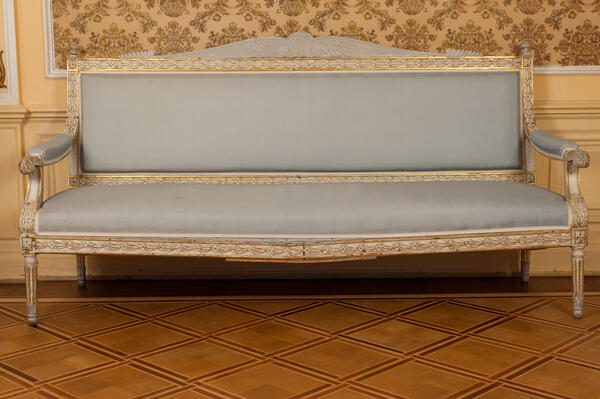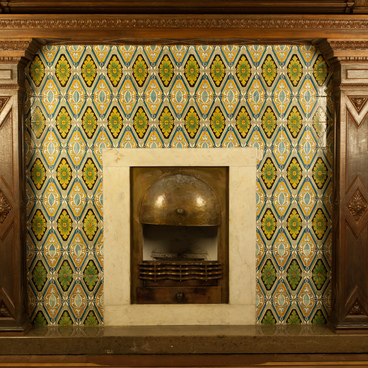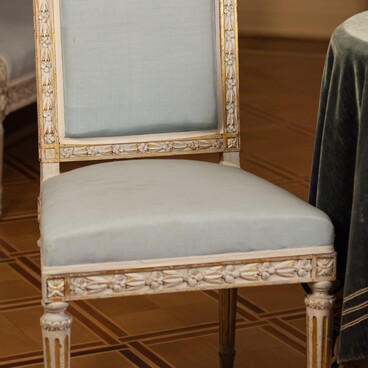This blue sofa was created in the first quarter of the nineteenth century in an unknown Russian furniture workshop. It is built on a rectangular frame and has a high backrest. The sofa is decorated with incised laurel foliage ornaments all along its rails and the back rail is topped with a beautifully carved crest and urn-shaped finials at the sides. Armrests and arm supports are curved, open-sided, have padded manchettes and are decorated with the same laurel motif. Turned legs are narrowed downwards.
Judging by its shape and ornamental design, this sofa is a product of a Russian workshop from the first quarter of the nineteenth century. It used to be part of the Hermitage collection.
Is there a reason why we don’t know the name of the person who built this elegant sofa? To find the answer, we will have to go back to the end of the 18th century, when Empress Catherine II, having economic and worldwide political troubles in mind, put an embargo on the import of foreign-made furniture. Her decision gave rise to national furniture industry, which appeared to serve the needs of the court and aristocracy. At the beginning Russian workshops were mostly run by foreign cabinet-makers, but in the first third of the nineteenth century the industry was already developed enough to eliminate the need for imported furniture. Top-class workshops which could realize the designs of the finest architects started opening, first in Moscow and Saint Petersburg, and later in other big cities, such as Orel, Yaroslavl, or Tver.
In addition to that, rich landlords had their own workshops. Those workshops were set in their country estates and operated by their serfs. As a result, everyday life of the nobility became so abundant with high quality and sometimes top-of-the-line furniture pieces that importing ones was no longer needed. At the same time, the fact that the craftsmen were serfs, would explain why these items are mostly anonymous.
This sofa is an example of Russian Neoclassicism with its clean-cut shapes, and new proportions and details inspired by classical Greco-Roman art. Its forms are monumental but not cumbersome, and the outline is light and elegant.
In the first third of the 19th century, Neoclassicism was integral to furniture design in Russia, evolving into what would later be called Russian Classicism. This style was so universal and prominent overall that it went down in history as a highlight of Russian applied arts.
Judging by its shape and ornamental design, this sofa is a product of a Russian workshop from the first quarter of the nineteenth century. It used to be part of the Hermitage collection.
Is there a reason why we don’t know the name of the person who built this elegant sofa? To find the answer, we will have to go back to the end of the 18th century, when Empress Catherine II, having economic and worldwide political troubles in mind, put an embargo on the import of foreign-made furniture. Her decision gave rise to national furniture industry, which appeared to serve the needs of the court and aristocracy. At the beginning Russian workshops were mostly run by foreign cabinet-makers, but in the first third of the nineteenth century the industry was already developed enough to eliminate the need for imported furniture. Top-class workshops which could realize the designs of the finest architects started opening, first in Moscow and Saint Petersburg, and later in other big cities, such as Orel, Yaroslavl, or Tver.
In addition to that, rich landlords had their own workshops. Those workshops were set in their country estates and operated by their serfs. As a result, everyday life of the nobility became so abundant with high quality and sometimes top-of-the-line furniture pieces that importing ones was no longer needed. At the same time, the fact that the craftsmen were serfs, would explain why these items are mostly anonymous.
This sofa is an example of Russian Neoclassicism with its clean-cut shapes, and new proportions and details inspired by classical Greco-Roman art. Its forms are monumental but not cumbersome, and the outline is light and elegant.
In the first third of the 19th century, Neoclassicism was integral to furniture design in Russia, evolving into what would later be called Russian Classicism. This style was so universal and prominent overall that it went down in history as a highlight of Russian applied arts.



